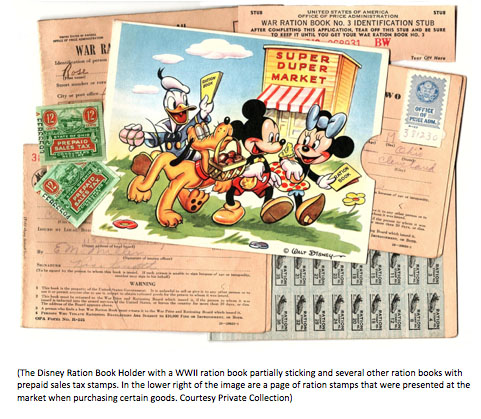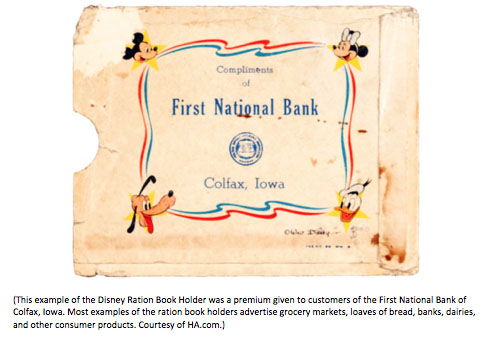
The Covid-19 pandemic has created shortages with certain items becoming scarce at the local grocery store during 2020. The retail shelves usually brimming with paper towels, toilet paper, disinfecting wipes, and cleaning sprays have become bare again, mostly due to hoarding. This hoarding is typical in crisis times and made me think about the countrywide rationing that went into effect at the beginning of WWII and how Walt Disney Productions helped to get the word out about conserving resources.
In February 2018, I wrote about the Disney produced public service announcement Out of the Frying Pan and into the Firing Line that extolled the virtues of saving bacon fat and meat drippings. That public service announcement, which played in theaters, was part of a much larger effort by the United States to institute rationing and resource conservation nationwide. During WWII, the Office of Price Administration (OPA), which was part of the United States Government’s Office of Emergency Management, handled goods rationing. The OPA was created by President Roosevelt’s Executive Order 8875 on August 28, 1941, with the purpose to “stabilize prices and rents and prevent unwarranted increases in them; to prevent profiteering, hoarding, and speculation; to assure that defense appropriations were not dissipated by excessive prices; to protect those with fixed incomes from undue impairment of their living standards; to assist in securing adequate production; and to prevent a post-emergency collapse of values.”(1)

The rationing and price controls’ objective was to prevent inflation and shortages of items and materials needed for the war effort. These controls extended to wages as well, all to stabilize prices and rents after the outbreak of WWII. To help stabilize prices and prevent inflation, the OPA issued ration coupon books to distribute food staples deemed in short supply equitably. The OPA administered this program through more than 8,000 ration boards across the country.(2)

The rationing books were produced in a series and issued to every American. Each ration book contained twelve pages, with most containing removable stamps that had to be given to the grocer upon purchase of certain rationed items such as sugar, meat, cooking oil, and canned goods. These ration books were made out of paper and meant to be used and discarded once the coupons were depleted. That created an opportunity for shrewd businesses to create ration book covers and holders to advertise and give them away as premiums to customers. Disney took advantage of this opportunity by creating a ration book holder that used his popular characters on both sides with space on the reverse side for a business advertisement—early cobranding.
Most ration book holders advertise grocery markets, banks, dairies, and other consumer products like C&H Sugar and Peter Pan Bread. One of the reasons for the advertising choices was that the woman took care of running their household, including grocery shopping, where the ration coupons had primarily been used. On March 5, 1943, a Gallup Poll asked Americans, “Do you understand how the food point rationing system works?” Not surprising that 76% of women answered “yes” compared to only 53% of men.(3) It is safe to say that the United States would not have won WWII without the women!

The Disney ration book holder features an illustration of Mickey Mouse, Minnie Mouse, Donald Duck, and Pluto leaving the “Super Duper Market” with their goods and holding their ration books. The holder is made of a heavy paper card stock and measures 5″ X 6 ½.” It is sealed on three sides with one end open to slip in a ration book, which has a circular indent for easy retrieval of the book when needed. On the reverse side of the holder is a red and blue ribbon-like frame that features the character’s head in each corner of the frame, leaving an open space for the business advertisement. In one example presented here, Bristow’s Food Market in Clovis, New Mexico, is the merchant that handed these holders out to its customers. There is another example of the same Disney ration book holder except with the reverse “Compliments of the First National Bank, Colfax, Iowa” as the business advertised.

The character drawings were most likely created by the Studio’s Publicity Art Department, headed then by Disney artist Hank Porter, known for designing many of the Disney WWII military insignias. It is also likely that one of the other artists in the unit, either Roy Williams, George Goepper, or Van Kaufman, created the characters’ drawings.(4) Porter is known for his mastery of the classic characters like the USS Booth Insignia featuring Donald Duck. Looking at the characters on these ration book holders, you can see that Minnie Mouse looks just off-model on the main cover illustration, and the character poses are not quite as dynamic as you might see in a Hank Porter drawing. On the reverse side, look at the length of Pluto’s snout, which is too long. Yes, the viewer knows it’s Pluto, but it is still off-model to those that know the characters well.

The Disney Ration Book Holders were used from early 1942 through approximately June 1946 when the Office of Price Administration shut down.(5) These Disney themed ration book holders have become scarce in recent years and only occasionally show up in an auction or as a lucky find. The example adverting the First National Bank is in poor condition; still, it sold in a 2016 Heritage Auction sale for nearly $90.00, including buyer’s premium.(6) Other examples in better shape have surfaced now and again, but as time marches, so does the scarcity increase for these Disney related pieces of WWII ephemera.
©2021 David Bossert
FOOTNOTES
1 – Executive Order 8875 on August 28, 1941
2 – Take A Closer Look: Ration Books, The National WWII Museum, New Orleans
3 – Take A Closer Look: Ration Books, The National WWII Museum, New Orleans
4 – Bossert, Dave, Hank Porter: Disney’s Go To Artist for Insignia Designs during WWII, Cartoon Research, March 11,
2019
5 – Jacobs, Meg; How About Some Meat?: The Office of Price Administration, Consumption Politics, and State
Building from the Bottom Up, 1941-1946. The Journal of American History, December 1997.
6 – Disney Character Ration Book Holder (Walt Disney, c. 1942), Heritage Auctions, lot #14679, July 24, 2016


 David A. Bossert is an award-winning artist, filmmaker, and author. He received his B.A. from CalArts School of Film and Video with a major in Character Animation. As a 32-year veteran of The Walt Disney Company, he contributed his talents to The Black Cauldron (1985), Who Framed Roger Rabbit (1988), The Little Mermaid (1989), Beauty and the Beast (1991), Aladdin (1992), Tim Burton’s The Nightmare Before Christmas (1993), The Lion King (1995), Fantasia/2000 (1999), and the Academy Award-nominated shorts Runaway Brain (1995), Dali/Disney Destino (2003), and Lorenzo (2004), among many others. Bossert is now an independent producer, creative director, and writer.
David A. Bossert is an award-winning artist, filmmaker, and author. He received his B.A. from CalArts School of Film and Video with a major in Character Animation. As a 32-year veteran of The Walt Disney Company, he contributed his talents to The Black Cauldron (1985), Who Framed Roger Rabbit (1988), The Little Mermaid (1989), Beauty and the Beast (1991), Aladdin (1992), Tim Burton’s The Nightmare Before Christmas (1993), The Lion King (1995), Fantasia/2000 (1999), and the Academy Award-nominated shorts Runaway Brain (1995), Dali/Disney Destino (2003), and Lorenzo (2004), among many others. Bossert is now an independent producer, creative director, and writer.













































































I imagine most Americans accepted wartime rationing as a matter of national interest, and certainly many were already inured to privations from having lived through the Depression. Still, I doubt that anybody was really happy about it. I remember hearing an episode of the Fibber McGee and Molly radio program where Fibber was grumbling about rationing, and all the other characters on the show took turns chastising him for being a bad citizen, even the little girl. I think the King’s Men might have sung a song about it. Stories promoting rationing, and slamming people who complained about it, were probably as common in the radio comedies of the forties as those Very Special “Say No to Drugs” episodes were in the TV sitcoms of the eighties and nineties.
Of course, most cartoon studios at this time, especially Warners, had gags about food rationing. Interestingly, Disney wasn’t one of them; perhaps because of the Army takeover of the studio, they didn’t dare bite the hand that fed them. The closest they got was on “Der Fueher’s Face”, which was more a comment on scarcity in Nazi Germany.